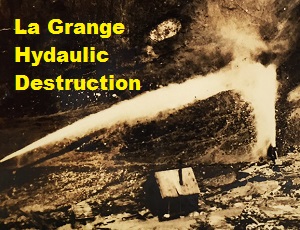
La Grange hydraulic mining destruction by Bear Photo Co. San Francisco
Most postcards, even from the 19th century, feature a historic building or natural wonder such as Half Dome in Yosemite. I came across a postcard from the early 20th century featuring the environmental destruction of hydraulic mining in Weaverville, California. The title of the image on the small postcard is “#21 Hydrulicing At La Grange Mines Weaverville Calif”. On the address side of the postcard is printed “Genuine Hand Made Photograph Bear Photo Co., San Francisco”.
La Grange hydraulic mine, one of the richest
The La Grange hydraulic mine was one of the largest producing hydraulic mines in California. Most interesting was that the La Grange’s highest gold production years were after the 1884 Sawyer Decision that shut down hydraulic mining in California. Because the hydraulic spoils or slickens washed out to the Pacific Ocean via the Trinity River, and not into the Central Valley, La Grange did not have to stop washing away mountains to collect placer gold.
Postcard of La Grange hydraulic mine photo addressed to Florence Wallen, Bowman, Placer County from Margie.
Postcard of monitors blasting away hillside
While the souvenir postcard was postmarked July 14, 1927, it is hard to know when the photo was actually taken. Multiple mining claims were consolidated under the Trinity Gold Mining Company that was sold to in part to the Baron and Baroness Ernest De LaGrange of France in 18931. The hydraulic operations were fairly continuous up until 1918. Thereafter, various companies worked the site sporadically until 1951.
Miles of water canals to supply wash water
The largest obstacle to year round hydraulic mining at La Grange was water availability. There were many miles of water ditches, flumes, tunnels and pipes utilized to bring water the mining site in present day Weaverville. But in time of low water flow into the holding ponds La Grange was reduced to using only two of their six monitors or water cannons to blast away at the hillside. The postcard shows two of the monitors in action. According to Hydraulic Mining in California A Tarnished Legacy by Powell Greenland, La Grange removed over 100,000,000 cubic yard of gravel and collected gold totaling approximately $8,000,000.
Postcard to Auntie Flo
This postcard was no doubt offered in a local store in Weaverville as a glimpse of the historic and rich past of the La Grange Mine. Written in pencil and addressed to Mrs. Florence Wallen, Bowman Placer Co., Box 52 (Care of a. Bishop), the postcard was a little note that a young girl had arrived in Weaverville on her journey.
Dear Auntie Flo,
I am now inx Weaverville. I am going on further pretty soon. Love you Margie
I will write again soon.
Did Margie enjoy her trip?
The penmanship looks to be of a young person in middle school. Margie probably had little understanding of the hydraulic mine pictured, but the La Grange would have still been visible in 1927. It’s kind of fun to wonder about Margie and Auntie Flo Wallen. Where was Margie going? Who was she with? How was that journey in 1927 when the roads through Trinity County were far less developed than they are today? Regardless, I hope Margie made it safely to her destination and she enjoyed the trip. I enjoyed the postcard eighty-eight years after it was mail to Auntie Flo in Bowman, California.
See also Salyer – Swanson hydraulic mine suspension bridge and history
1. Hydraulic Mining in California A Tarnished Legacy by Powell Greenland, The Arthur H. Clark Company, Spokane Washington, 2001. Lib. Congress Cat. Card No. 00-040444 ISBN 0-87062-300-1